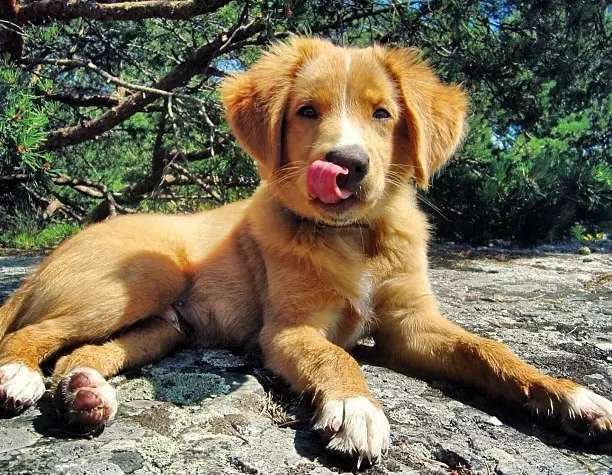On the New Scotland Peninsula in southern Canada, there are ducks and geese that migrate with the seasons. In order to better hunt these ducks and geese, hunters used local Indian reddish-brown dogs to develop the Nova Scotia Duck Hunting Hound. When hunting, they usually only need to wag their tails and jump around on the shore, and the ducks in the water will swim to the shore driven by curiosity. At this time, the hunter hiding in the dark can take the opportunity to catch the duck.
Of course, today’s Nova Scotia Duck Hunting Retriever appears more in front of everyone as a family companion dog. Many people will be attracted by its tawny hair and melancholy eyes from time to time. , so the popularity of this dog on the market is still very high, so what points should everyone choose from?

One , Personality
The Nova Scotia Duck Hunting Retriever is an outstanding representative of lively, playful, loyal, intelligent and easy to train. When you go to a pet agency to make a selection, you can quickly feel their enthusiasm. The selection criteria for personality are simple, mainly based on which Nova Scotia Duck Retriever is most willing to interact with you.
2. Body shape
The Nova Scotia duck hunting retriever is a medium-sized dog with a well-proportioned body and compact structure. The dog has well-developed muscles and thick bones. , with a high degree of agility, alertness and resilience. When it develops normally, its shoulder height is: 48~51cm for male dogs and about 45~48cm for female dogs; its weight is 20~23 kg for male dogs and 17~20 kg for female dogs.
3. Hair
The hair is the characteristic of the Nova Scotia duck hunting retriever. It is a typical double coat, with the inner layer short and The thick, medium-length outer layer has a slight wavy curl and is highly water-resistant. In color, the colors are various shades of red or orange, somewhat resembling a Golden Retriever, but the Nova Scotia Duck Hunting Retriever usually has some white markings on the tip of the tail, feet and chest. So everyone needs to pay more attention to these parts.
4. Facial features
The bridge of the nose should be conical and the nostrils should be open. The color should be coordinated with the color of the hair or black. The eyes are relatively far apart, almond-shaped, medium in size, amber to brown in color, and express a friendly, alert and intelligent look. Ears medium size, triangular, setTaller, with shorter hair on top. The mouth is strong and the teeth inside are arranged in a scissors bite.
5. Limbs
The forequarter bones are straight and strong, with sloping shoulders. Hindquarters, broad and muscular. Feet are of medium size and strong, with well-arched toes and thick pads. On the basis of these characteristics, it is also necessary to observe the gait. Under normal circumstances, the step is pleasant and elastic, the gait is light and lively, showing good driving ability, and the topline remains level during movement.
6. Tail
Its tail follows the laws of nature, is slightly tilted and very strong, with gorgeous and thick long hair connected to the spine. Very good and down to the elbow joint. When the Nova Scotia Duck Hunting Hound is alert, its tail will be set very low, and when it is in motion, its tail will be in an arc, but It does not come into contact with the body.
The Nova Scotia Duck Hunting Retriever loves to play. If you take it home, you will often see it running around with slippers and toy balls in its mouth. If you train it well, it can become a good assistant in your life. Okay, that’s it for today’s sharing.